| dc.contributor.advisor | Richard J. Temkin. | en_US |
| dc.contributor.author | Smirnova, Evgenya I | en_US |
| dc.contributor.other | Massachusetts Institute of Technology. Dept. of Physics. | en_US |
| dc.date.accessioned | 2008-03-26T20:31:50Z | |
| dc.date.available | 2008-03-26T20:31:50Z | |
| dc.date.issued | 2005 | en_US |
| dc.identifier.uri | http://dspace.mit.edu/handle/1721.1/32294 | en_US |
| dc.identifier.uri | http://hdl.handle.net/1721.1/32294 | |
| dc.description | Thesis (Ph. D.)--Massachusetts Institute of Technology, Dept. of Physics, 2005. | en_US |
| dc.description | "June 2005." | en_US |
| dc.description | Includes bibliographical references (p. 181-184). | en_US |
| dc.description.abstract | In this thesis I present the design and experimental demonstration of the first photonic band gap (PBG) accelerator at 17.140 GHz. A photonic band gap structure is a one-, two- or three-dimensional periodic metallic and/or dielectric system (for example, of rods), which acts like a filter, reflecting rf fields in some frequency range and allowing rf fields at other frequencies to transmit through. Metal PBG structures are attractive for the Ku-band accelerators, because they can be employed to suppress wakefields. Wakefields are unwanted modes affecting the beam propagation or even destroying the beam. Suppression of wakefields is important. In this thesis, the theory of metallic PBG structures is explained and the Photonic Band Gap Structure Simulator (PBGSS) code is presented. PBGSS code was well benchmarked and the ways to'benchmark the code are described. Next, the concept of a PBG resonator is introduced. PBG resonators were modelled with Ansoft HFSS code, and a single-mode PBG resonator was designed. The HFSS design of a travelling-wave multi- cell PBG structure was performed. The multicell structure was built, cold-tested and tuned. Finally, the hot-test PBG accelerator demonstration was performed at the accelerator laboratory. The PBG accelerating structure was installed inside a vacuum chamber on the Haimson Research Corporation (HRC) accelerator beam line and powered with 2 MW from the HRC klystron. The electron bunches were produced by the HRC accelerator. The electron beam was accelerated by 1.4 MeV inside the PBG structure. | en_US |
| dc.description.statementofresponsibility | by Evgenya I. Smirnova. | en_US |
| dc.format.extent | 184 p. | en_US |
| dc.language.iso | eng | en_US |
| dc.publisher | Massachusetts Institute of Technology | en_US |
| dc.rights | M.I.T. theses are protected by
copyright. They may be viewed from this source for any purpose, but
reproduction or distribution in any format is prohibited without written
permission. See provided URL for inquiries about permission. | en_US |
| dc.rights.uri | http://dspace.mit.edu/handle/1721.1/32294 | en_US |
| dc.rights.uri | http://dspace.mit.edu/handle/1721.1/7582 | en_US |
| dc.subject | Physics. | en_US |
| dc.title | Novel photonic band gap structures for accelerator applications | en_US |
| dc.type | Thesis | en_US |
| dc.description.degree | Ph.D. | en_US |
| dc.contributor.department | Massachusetts Institute of Technology. Department of Physics | |
| dc.identifier.oclc | 61343867 | en_US |
